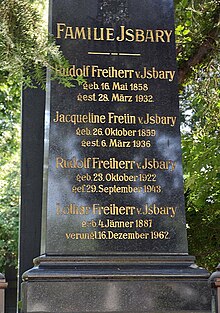Rudolf of Isbary
Rudolf Friedrich Ernst Freiherr von Isbary (born November 14, 1827 in Leipzig ; † June 9, 1892 in Vienna-Hütteldorf ) was an Austrian textile industrialist, member of the Imperial Council and President of the Vienna Chamber of Commerce .
Life

Rudolf Friedrich Ernst Isbary, the son of the married couple Carl August Isbary (* 1772), from a Greek family in Nauplia ( Nafplio ) in the Peloponnese and Christine Elisabeth, née Heinicke, from Leipzig, received his education in his native city Leipzig. He moved to Vienna in 1844, where he took a job at the August Koch export house, for which he ran a commission business in Livorno from 1849-52 to sell Austrian textiles in as yet undeveloped sales areas such as Italy, Tunis, Algiers and Egypt. After brilliant sales successes, he joined the company as a partner in 1852 and, above all, expanded its export activities to Europe and America.
Company foundations in Vienna and Graslitz
In 1853, Rudolf Isbary married Louise Hlawatsch (1834–1898), daughter of Karl Hlawatsch in Vienna, and in 1856, with his father-in-law, changed his woolen goods production in Vienna- Mariahilf to the Shawl factory Hlawatsch u. Isbary around. The prevailing fashion trend and Isbary's extensive trade connections ensured sales, which were constantly improved thanks to new production processes, so that in 1857 an own trading post was opened in Gmünd in Lower Austria and in 1860 a branch in New York . Starting with broché shawls, smooth and embroidered cashmere scarves in tasteful designs have also been produced since 1862. During the years 1860 to 1875, the company produced a total of around 500 employees around 800,000 scarves (shawls). At the beginning of the 1880s, the company increasingly turned to the production of fabrics for women's clothing and, after temporary accommodation in Asch, today's Aš , relocated its headquarters to Graslitz in 1889 , in what is now western Bohemia .
Economic policy activities
In addition to his success as an industrialist, Rudolf Isbary was also active in numerous functions in public life. Since 1861 a member of the Lower Austrian Chamber of Commerce, he was elected Vice-President in 1872, President in 1883 and from 1873-80 sent to the Austrian Reichsrat as its first member (Reich Electoral Code of April 2, 1873), where he was an economic expert in special committees. From 1862 he served as a member of the Lower Austrian state parliament, from 1865–74 as a commercial court assessor. Isbary also repeatedly participated in the organization of major business shows: in 1873 he was president of the arrangement department of the Vienna World Exhibition Commission , in 1876 he was vice-president of the Austrian central commission and chairman of the executive committee for Paris. In 1880 Isbary was appointed curator of the Austrian Museum of Art and Industry . In 1886 he founded an information office for exports and imports and initiated an aid campaign to boost the Lower Austrian ironmongery industry and to set up training workshops. From 1887, Isbary was president of the Lower Austrian Escompte Society , one of the most important financial institutions of the Austro-Hungarian monarchy . In addition, he was active on several economic policy committees.
recognition
In 1883 he and his descendants were raised to the Austrian hereditary nobility as Freiherr von Isbary.
progeny
With his wife Louise, nee Hlawatsch, (1834 to 1898) he had a son Rudolf (born on May 16, 1858, died on March 28, 1932 in Vienna). Baron Rudolf von Isbary Junior succeeded his father in the company, married Jacqueline Schürer von Waldheim (1859-1936), built the Palais Isbary in Schmöllergasse in Vienna and acquired a large estate in Lower Austria's Pielachtal with Fridau Castle as the administrative center, which formerly had an extent of 8000 hectares. The Isbary'sche property management is continued by his heirs.
literature
- Isbary in: Taschenbuch der Freiherrlichen Häuser (1871–1942), year 1895; 1939, Justus Perthes, Gotha
- Heribert Sturm : Biographical lexicon on the history of the Bohemian countries. Published on behalf of the Collegium Carolinum (Institute) , Vol. II, R. Oldenbourg Verlag Munich 1984, ISBN 3-486-52551-4 , p. 6
- Hannes Stekl: Isbary, Rudolf. In: New German Biography (NDB). Volume 10, Duncker & Humblot, Berlin 1974, ISBN 3-428-00191-5 , p. 187 ( digitized version ).
- Austrian Biographical Lexicon 1815–1950 (ÖBL), I 1957 f., Vol. 3
- The big industry of Austria, Vol. 4 1898, pp. 154–156
- Wiener Zeitung (Abendpost) July 9, 1892
| personal data | |
|---|---|
| SURNAME | Isbary, Rudolf von |
| ALTERNATIVE NAMES | Isbary, Rudolf Friedrich Ernst Freiherr von (full name) |
| BRIEF DESCRIPTION | Austrian textile industrialist, member of the Reichsrat and President of the Vienna Chamber of Commerce |
| DATE OF BIRTH | November 14, 1827 |
| PLACE OF BIRTH | Leipzig |
| DATE OF DEATH | June 9, 1892 |
| Place of death | Vienna-Hütteldorf |